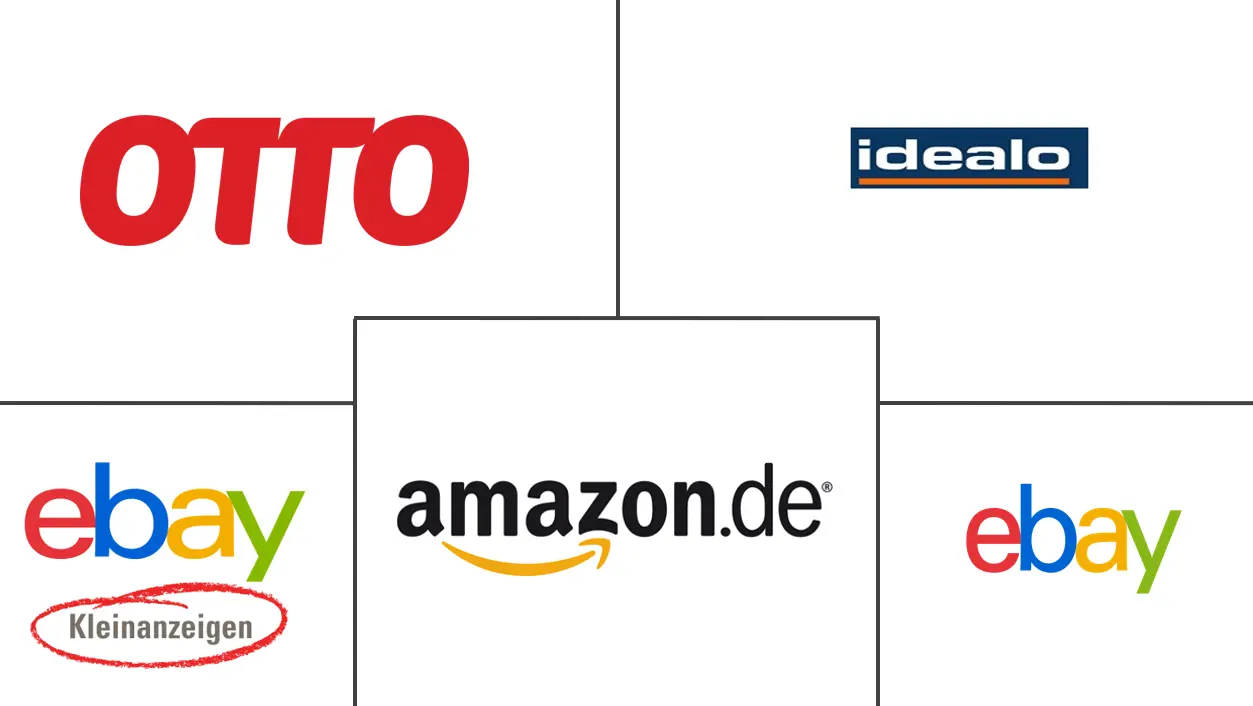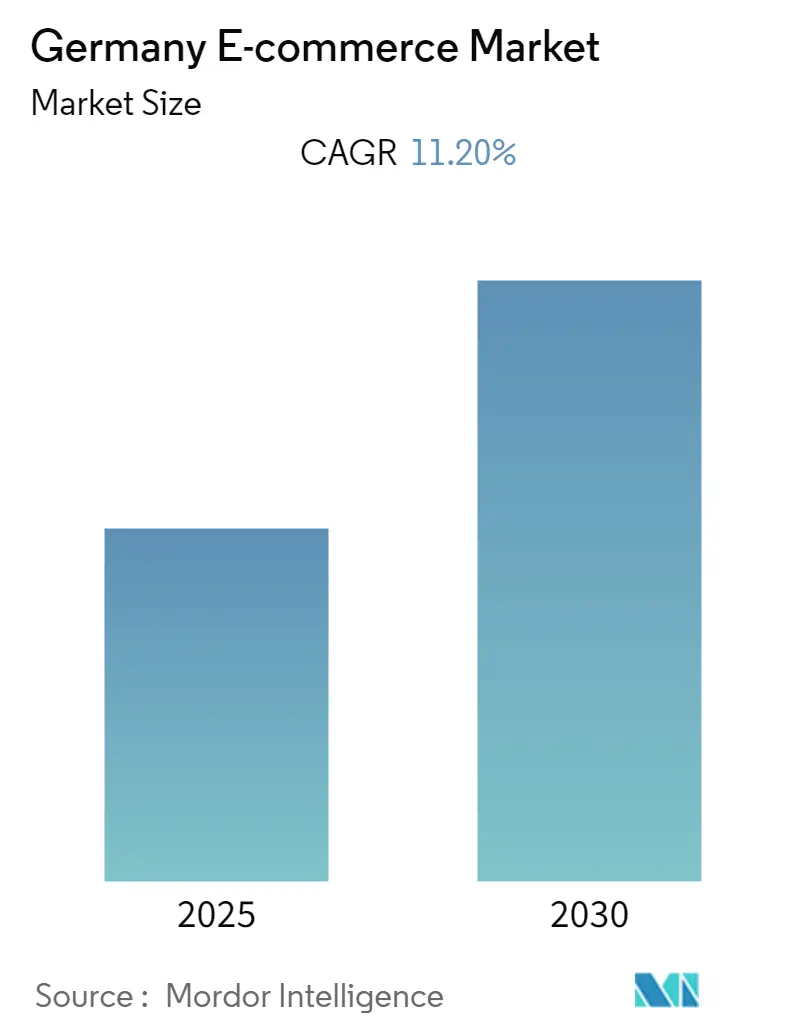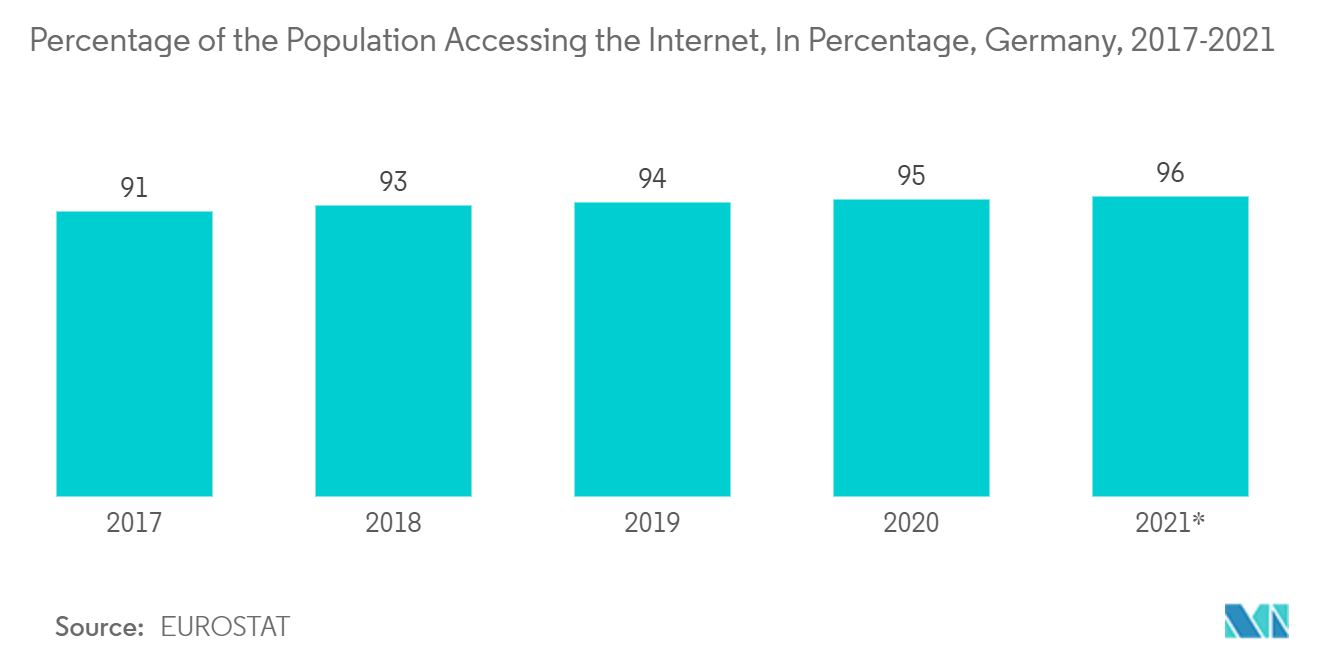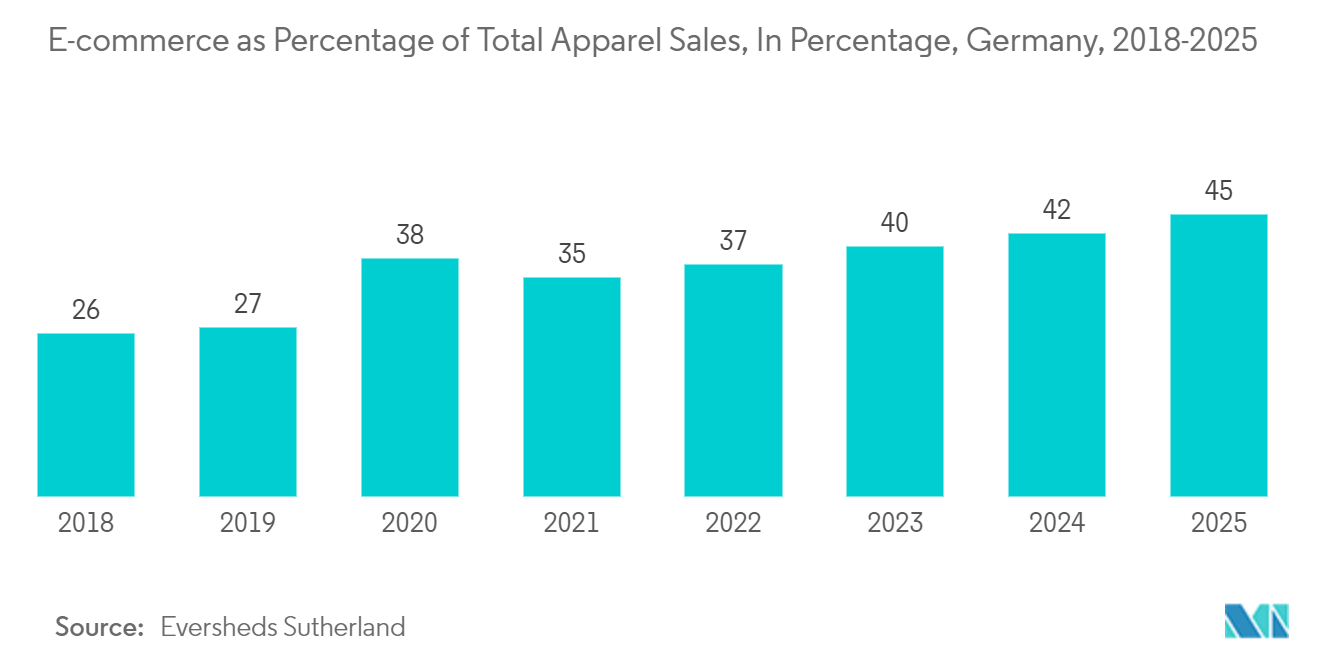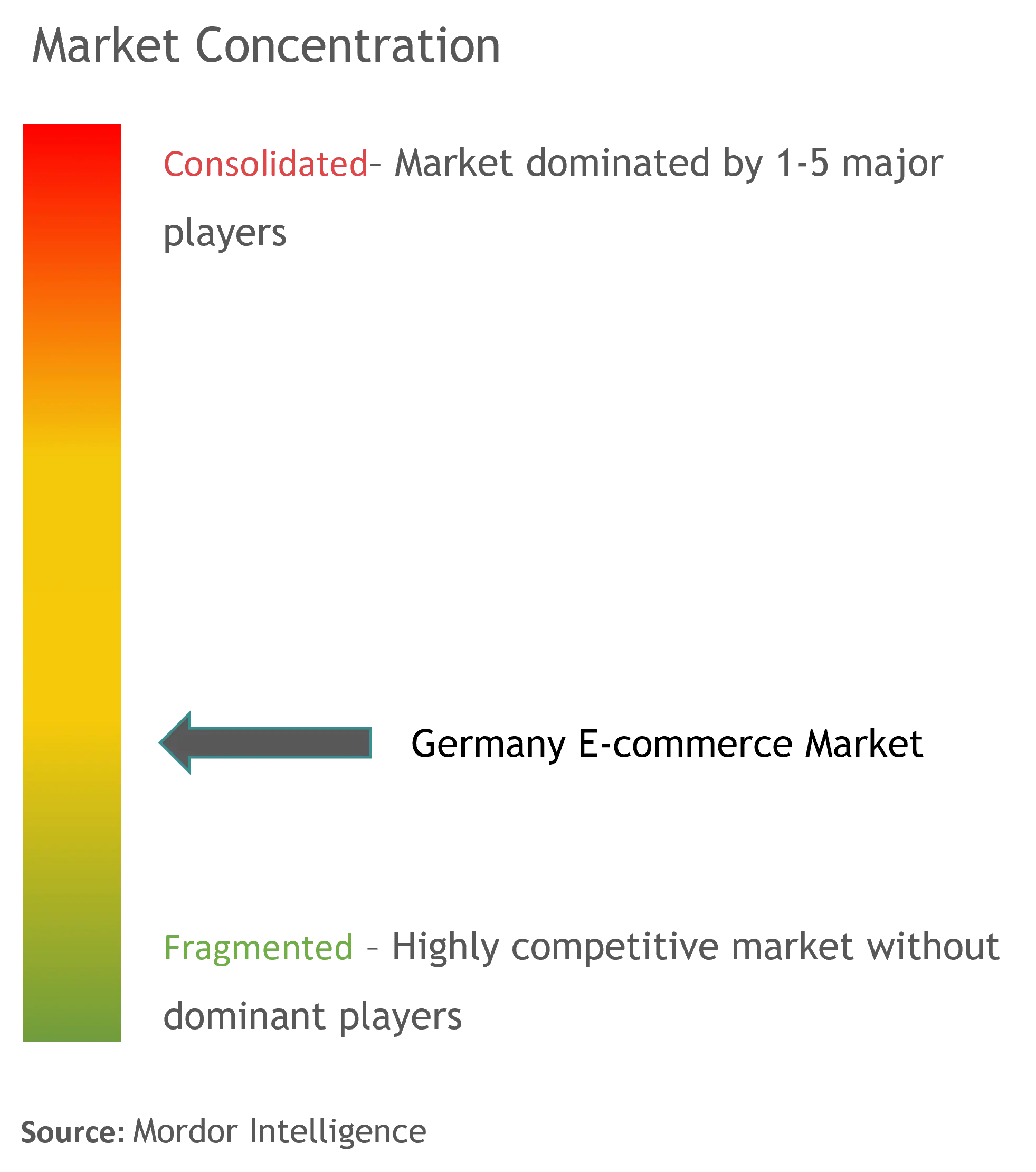Germany E-commerce Market Analysis
The Germany E-commerce Market is expected to register a CAGR of 11.2% during the forecast period.
- The high internet penetration and the increasing adoption of smart devices in the region are primarily driving the market for e-commerce platforms. Due to the rising urbanization, several conventional businesses are inclined toward e-commerce platforms to expand their consumer base and market share, control overhead costs, and improve product sales.
- Most online stores in Germany accept PayPal and credit cards as payment methods. Many websites accept bank transfers, invoice/buy now, and pay later. Online customers can cancel orders and return goods or services within 14 days, for any reason and with no justification. With so many advantages that e-commerce companies offer, the region's e-commerce market is further expected to grow over the forecast period.
- Furthermore, mobile shopping has become more prevalent in the region, and instant payments suit the needs of modern consumers. Additionally, smartphone usage is growing faster in Germany, increasing the use of e-wallet payment methods. This growth is expected to continue as retailers improve their mobile websites and provide more convenient shopping methods on mobile devices.
- However, if an e-commerce company wishes to reach potential customers in Germany via its website or web store, it must comply with some rules and regulations, such as VerpackG. According to the law, manufacturers, distributors, or importers of packaging or packaged products must contribute to the disposal costs to assume responsibility for the product and its return and disposal. The VerpackG affects manufacturers, distributors, or importers of sales packaging: packaging that typically accumulates as waste for the end consumer. This type of regulation can hamper the growth of the e-commerce market in Germany.
- The appearance of the COVID-19 outbreak and its spread across the globe has changed the lives of millions of people. During the COVID-19 pandemic, Germany was exposed to the imposition of travel restrictions, lockdowns, and shop and service points closure. Consequently, COVID-19 changed the habits of consumers as well as shopping channel preferences. The growth of online shopping reshapes the German retail market and causes companies to adapt to changed market requirements.
Germany E-commerce Market Trends
Rising Adoption of M-commerce
- M-commerce, also known as mobile commerce, involves shopping online through mobile devices like smartphones or tablets. Mobile shopping apps are increasingly becoming more popular amongst retailers and regional shoppers.
- The growth of the e-commerce market in Germany can be attributed to the considerable proportion of the population who own smartphones. Moreover, the rising adoption of m-commerce in Germany is also contributing to the growth of the country's e-commerce industry. This growth is expected to continue as retailers improve their mobile websites and provide even more convenient shopping methods on mobile devices.
- One of the primary reasons for the increase in m-commerce popularity is that many market players in the region have developed dedicated apps. Also, searching for products and payment processes are becoming more easier. Many applications allow connecting consumers with a credit card, another aspect driving the market's growth.
- As per EUROSTAT, the proportion of individuals aged between 16 to 74 in the European Union who ordered or brought goods and services over the internet for private use continued to rise. In 2021, it stood at 66 %, an increase of 15 percentage points compared with 2016. More than three-quarters of individuals in Germany, among other European nations, ordered or bought goods or services over the internet in 2021.
- As per the e-commerce association BEVH, the mobile e-commerce revenue in Germany increased by 56.5% to EUR 39.9 billion within the past two years of the pandemic and made up around 40% of e-commerce goods sales in 2021. A year ago, sales generated by mobile devices stood at EUR 28.1 billion.
Fashion and Apparel Segment is Expected to Grow at a Significant CAGR
- With the rising adoption of e-commerce, consumers have more choices than ever before. Moreover, now companies are providing a tailored online shopping experience. The fashion segment in the market is further expected to grow over the forecast period.
- Textile and clothing retailers are connected because textile manufacturing leads to the production and sale of clothing items. Moreover, the textile and clothing market is one of the leading industries in Germany. Textiles also include sportswear, workwear, various home textiles, and bedding. The rise of online shopping among consumers also leads to changing customer preferences, quality standards, and convenience, among other factors.
- As reported by Eversheds Sutherland, E-commerce as a percentage of total apparel sales in the country was 26% in 2018 and is further expected to increase to 45% in 2025. online apparel sales significantly increased as a result of the COVID-19 outbreak. In 2020, e-commerce accounted for 38% of all apparel sales, about 11% higher than the previous year.
- German consumers are well informed and very demanding. Consumers compare and look for the best deal: value for money is a central term in the German worldview before purchasing. E-commerce platforms provide value for money, ease of convenience, and the latest fashion trends, driving the nation's market. Moreover, sustainability is dominating consumer priorities and fashion choices. Consumers increasingly look for information regarding the source of the materials and how products are made. In response, many companies are expanding their sustainable strategies and working to boost the sustainability of their regional supply chains.
Germany E-commerce Industry Overview
The German e-commerce market is fragmented owing to the presence of a large number of market players, which hold a significant amount of the market share. Some key players in the German e-commerce market are Amazon.de, eBay.de, eBay Kleinanzeigen, Otto.de, etc.
- January 2022 - Zalando, one of Europe's leading E-commerce platforms for fashion and lifestyle, invested in material science company Ambercycle Inc. Zalando announced the closing of its Series A financing from Zalando and H&M CO: LAB, KIRKBI, Temasek, and BESTSELLER's Invest FWD. Ambercycle aims to develop the fashion industry's infrastructure and materials for circularity with this new funding.
- September 2021 - Amazon announced to expand of its successful cooperation with Tegut to include a new delivery area. It now offers Prime members in the Kassel area the opportunity to order groceries and everyday items online from a local Tegut branch. The approximately 10,000 available products from the Tegut range include fresh, chilled, and frozen goods, organic products, regional and sustainable food and beverages, drugstore items, and pet food.
Germany E-commerce Market Leaders
-
Amazon.de
-
eBay.de
-
eBay Kleinanzeigen
-
Otto GmbH
-
Idealo Internet GmbH
- *Disclaimer: Major Players sorted in no particular order
Germany E-commerce Market News
- February 2022 - Amazon announced opening a new German logistics center in Kaiserslautern, Rhineland-Palatinate, which is scheduled to start operations in autumn 2022. With the new logistics center, Amazon will create more than 1,000 attractive jobs within the first year of operation and offer competitive wages and benefits. Amazon continues to expand its German logistics network to meet customer demand and expand product selection.
- January 2022 - Zalando, one of the leading European online platforms for fashion and lifestyle, announced to expand its assortment with Apple and Beats products in Austria, Germany, France, Italy, and Switzerland. With this new update, the customers will be able to discover Apple Watch, AirPods, HomePods, and Apple accessories in the Tech Accessories & Audio section of Zalando's store starting from February 2nd.
- September 2021 - Amazon announced that it would continue investing in Germany and creating jobs. The company plans to construct eight new logistics buildings in Germany by the first half of 2022. The new logistics locations are in Dummerstorf (logistics center, 2022), Erding (sorting center, 2022), Friedrichsdorf (distribution center, 2021), Helmstedt (logistics center, 2022), Hof/Gattendorf (logistics center, 2022), Neu-Ulm (distribution center, 2021 ), Weiterstadt (distribution center, 2022) and Wenden (distribution center, 2021).
Germany E-commerce Industry Segmentation
E-commerce refers to the internet's commercial transaction of goods and services. These transactions are primarily conducted via various business models, such as B2C and B2B. E-commerce platforms offer advantages such as minimized inventory cost, improved profit margins, various discounts, hassle-free delivery of goods and services, etc.
The Germany E-commerce Market is Segmented into B2C E-commerce (Beauty and Personal Care, Consumer Electronics, Fashion and Apparel, Food and Beverage, Furniture and Home), and B2B E-commerce.
| By B2C E-commerce | Market Size (GMV) for the Period of 2017-2027 | ||
| Market Segmentation - by Application | Beauty and Personal Care | ||
| Consumer Electronics | |||
| Fashion and Apparel | |||
| Food and Beverages | |||
| Furniture and Home | |||
| Others (Toys, DIY, Media, etc.) | |||
| By B2B E-commerce | Market Size for the Period of 2017-2027 | ||
Germany E-commerce Market Research FAQs
What is the current Germany E-commerce Market size?
The Germany E-commerce Market is projected to register a CAGR of 11.2% during the forecast period (2025-2030)
Who are the key players in Germany E-commerce Market?
Amazon.de, eBay.de, eBay Kleinanzeigen, Otto GmbH and Idealo Internet GmbH are the major companies operating in the Germany E-commerce Market.
What years does this Germany E-commerce Market cover?
The report covers the Germany E-commerce Market historical market size for years: 2019, 2020, 2021, 2022, 2023 and 2024. The report also forecasts the Germany E-commerce Market size for years: 2025, 2026, 2027, 2028, 2029 and 2030.
Our Best Selling Reports
Germany E-commerce Industry Report
Statistics for the 2025 Germany E-commerce market share, size and revenue growth rate, created by Mordor Intelligence™ Industry Reports. Germany E-commerce analysis includes a market forecast outlook for 2025 to 2030 and historical overview. Get a sample of this industry analysis as a free report PDF download.

